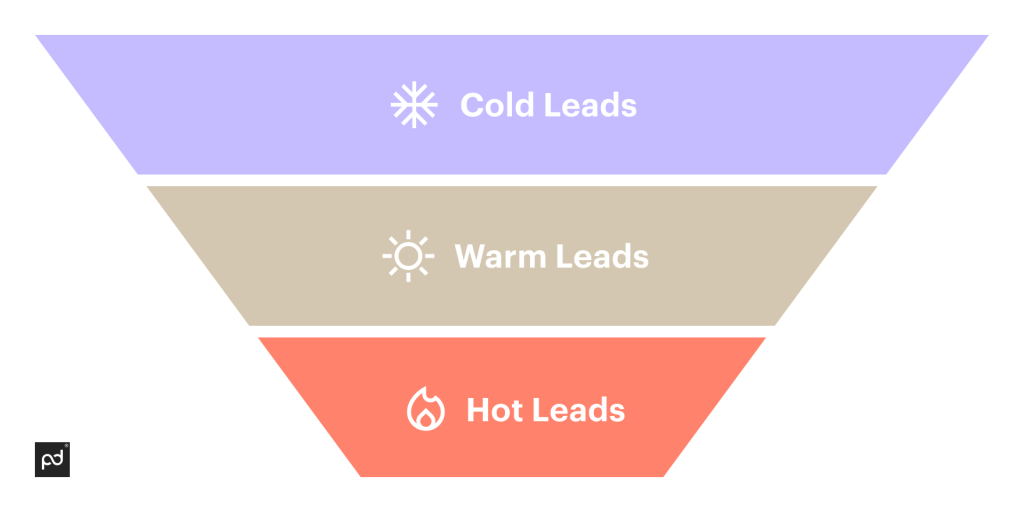An effective lead management process is one of the most critical factors driving sales through your funnel.
When you capture the attention of a potential customer, this is the moment a lead is born.
However, how that lead plays out, whether that person becomes a paying customer or client, is another matter.
Optimizing your lead management process, in other words making sure all leads, once hooked, have the maximum chance of converting to a sale, is vital to your business’s success.
Key takeaways
- Lead management involves monitoring and assessing leads to gauge their likelihood of converting into established customers or clients.
- There are four benefits to a lead management process: segmentation, better budget allocation, agent job made easier, and better customer journeys.
- There are three types of leads: cold leads, warm leads, and hot leads.
- The lead management process is made up of five main stages: capturing, tracking, scoring, segmentation, and nurturing.
- There are five crucial lead management metrics to keep track of: sources, scores, conversion time, conversion rates, and customer value.
- Simplify the lead management process with PandaDoc’s all-in-one software tool.
What is lead management
Lead management tracks and analyzes leads to see how likely they are to turn into fully-fledged customers or clients.
Your leads and prospects are the lifeblood of your business.
To be classed as a lead, someone will have shown interest in your brand by interacting with it somehow.
A lead can also be a likely customer based on demographics or being part of a particular target segment of the population.
Leads at the top of your sales funnel can only be driven further along the pipeline if you deploy the right tactics.
Sound lead generation and management of potential customers means having a system to evaluate and focus on the most promising leads first.
In essence, this is what lead management is.
What are the different types of leads
A crucial part of the lead management process is the initial lead capture, hooking potential leads and drawing them into your sales funnel.
But not all leads are made equal. Let’s look at the different types of leads.
In basic terms, there are cold leads, warm leads, and hot leads.

Cold leads
Cold leads are at the very top of your sales funnel.
These are prospects that fit the profile of your target customers but as yet, haven’t had any real interaction with your business.
Cold leads are the hardest work as it takes skill, persuasion, and enticing content and strategies to convert them into customers.
If you can engage cold leads, they can be driven further down the sales funnel.
But if there is no sign of a cold lead getting any warmer, the skill of managing leads also means knowing when to let them go.
Warm leads
Warm leads are a little further along the sales funnel, around the middle. They are prospects who are not completely new to your brand.
Perhaps they have signed up for your newsletter, followed your business on social media, accessed your website content, or used a chatbot.
They have shown an interest in your products and services.
You are on safer ground with warm leads, but they are not yet at the stage of actively wanting to purchase or convert.
These are the types of leads you must encourage with a clear call to action.
Warm leads can also respond to being contacted personally and encouraged to covert.
Hot leads
Hot leads are the safest bet in terms of converting. They are right at the bottom of your sales funnel and are highly likely to become paying customers or clients.
They have likely checked out your business’s offering and are ready to commit.
They still need nurturing in terms of the final choice of goods or services and will appreciate being persuaded with discounts and offers.
Somewhat harder sales tactics are appropriate with hot leads. They aren’t so likely to be scared off and will appreciate more information.
Clearly showing the benefits of a particular choice or purchase option will not annoy them.
Four benefits of lead management
An effective sales lead management system benefits your business in various ways.
For example, it can optimize your sales cycle, speeding up the repeatable processes salespeople use to turn a lead into a customer.
It can also ensure better personalization for target customers and better use of your sales team’s time and budget.
Here are four benefits of a lead management system:
1. Segmentation
We might group them together to better understand their needs and encourage them along the sales funnel, but leads are individuals.
Customers prefer tailored contact and experiences, and segmentation is the way to facilitate this.
Segmentation is an important part of lead management. It facilitates better customization and tailoring of your sales approach.
Segmentation lets you know which adverts or offers to send to which customers and which customers you can call or email.
2. Better budget allocation
A good return on your marketing budget is another benefit of lead management.
It helps you decide where your potential leads are coming from and where to spend on campaigns.
3. Agent job made easier
A sales agent’s job is made much easier with a lead management process.
Through lead management, potential leads can be sent to agents best placed to capitalize on them.
It can also help equip those agents with the insights they need to achieve conversions.
Good lead management software can also help agents by predicting their performance, spotting any issues, and providing rewards and encouragement for them to up their games and meet their targets.
4. Better customer journeys
A smooth journey makes a customer far more likely to convert.
Lead management can help ensure that each touchpoint through your sales cycle is frictionless and effective.
Lead management software can also help you manage engagement and marketing strategies like email campaigns.
It means you can separate existing customers from leads and tailor contact accordingly.
What is the lead management process flow
In a lead management process diagram, you’ll see how leads are first captured, tracked, scored, segmented, and nurtured.
This is the lead management process flow.
Each stage is essential, as well as how each stage affects the next.
The success of your sales performance rests on how your sales team moves their focus and activity from one stage to another.

What are the main stages of the lead management process
Let’s look at what occurs in each stage of the lead management process and why each is important to your overall sales results.
1. Lead capturing
Lead capturing means first generating leads.
This can be through various prospecting channels such as email campaigns, social media posts and activity, and advertising.
In response to these tactics, potential customers will visit your website or interact with your brand in another way.
At this stage, the lead management process moves on a step.
It then becomes a case of tracking those leads.
2. Lead tracking
Lead tracking means gathering more information about the leads you’ve brought in.
It’s vital to track the origin of each lead as you can then choose the best way to further engage the prospect.
An automated lead management system can easily gather helpful information on each lead.
It can also let you know which links or websites are bringing interest to your brands.
It will also tell you from where geographically and from which demographics your leads are coming.
3. Lead scoring
Then it’s time to analyze the quality of your leads.
Are they the right kind of potential customer for your business?
In other words, are they likely to become a paying customer? Or is their initial interest likely to come to nothing?
This comes down to drilling down into the actions and behavior of each lead.
Assess if they are revisiting your website, reading your content, or answering marketing messages.
Evaluating their behavior and level of engagement will give you a lead score.
This score will reveal how likely they are to move down the sales funnel.
4. Lead segmentation
The next step involves segmenting the leads so that the right sales team members can work on them.
You might have certain parts of your team earmarked for smaller companies, larger concerns, or specific types of organizations.
These differences will determine how the sales staff approach and further engage the leads.
5. Lead nurturing
Lead nurturing means carefully encouraging the leads your team has brought along with them so far.
Even at this stage, not all leads will turn out to be productive, at least not immediately.
Staying in touch with a lead, even if they aren’t ready to buy straight away, is why lead nurturing is vital.
Today’s interested lead, with good experience of interacting with your team, will be tomorrow’s firm sale.
What are the metrics to track for lead management
We’ve mentioned that data about your leads is important in order to have a good lean management process.
In brief, these are the metrics you should log:
- Sources: Where exactly are your leads coming to your brand from?
- Scores: How much potential do these leads have? How likely are they to convert?
- Conversion time: How long does it take for your leads to convert to paying customers?
- Conversion rates: How long are conversions taking on average? This demonstrates how effective your lead management is.
- Customer value: This important metric shows the value of each customer to your business.
How to manage sales leads in five simple steps
A good lead management strategy means keeping on top of the various stages and leveraging technology where you can to streamline and organize.
Let’s look at five simple steps for how to manage leads effectively.
- Define the leads you want to attract to your business.
- Identify your lead sources. Which marketing channels are bringing them in?
- Segment your leads so that your team can better develop them.
- Nurture your leads. Remember today’s interested lead is tomorrow’s customer.
- Leverage analytics to improve your sales lead management process.
Best practices and tips for lead management success
The exact nature of your sales cycle will depend on your business, but there are some common best practices for successful lead management.
Monitor and maintain your lead generation
Ensure your lead generation is fit for purpose and functioning well for your business.
Do an audit of the various touchpoints, and decide which are the most valuable to your sales results.
On closing deals, look back at the customer journey, which channels engaged your leads, and which tactics worked the best for your type of business and your sales objectives
Make sure your data is clean
The quality of your data is paramount if you mean to use it to give you worthwhile insights.
With data, quality is more important than quantity. Gather your own data, and don’t be tempted to rely on outsourced third parties.
Use lead management software to gather your own data.
Useful guidance for future actions can only come from highly accurate, clean data derived from your own business.
Align with your sales funnel
Your lead management process should be in step with your sales funnel.
The length of the sales funnel will depend on your business.
Some have short pipelines, others much longer.
Sales reps should be fully aware of your sales funnel and be able to help create a sales management process that aligns with how sales generally proceed along your pipeline.
Encourage marketing and sales to collaborate
Using the right lead management software can bring these two vital departments together, and give them a unified picture of how both teams are contributing to sales.
Both departments play their part in lead generation.
Aligning their tasks is easier if marketing automation software and customer relationship management software can be linked to provide comprehensive data.
How to choose lead management software
Choosing the best lead management software means making sure you consider the following.
- Make sure the software matches your budget and needs. There are big variations in price and capabilities when it comes to software. Make sure you choose software that’s the right fit, and above all, make sure it’s worth your money.
- Know what lead tracking features you need. Again there are variations in what each type of software offers. It’s vital to establish exactly what you most want to know and what you need software to do.
- Make sure it’s user-friendly, with an interface that your team can get on with. It’s also a good idea to make sure it has good customer support.
- Make sure your chosen software has the capability to grow and extend as your business needs develop and change. Look for scalable systems that have the capacity to increase and adapt.
The advantages of automation for lead management
Lead management is easier and more successful when automated with specialist software.
Manually gathering and analyzing data can be difficult and less effective, as it involves combining disparate information stored in spreadsheets and collected from various analytical methods to get results.
Automation gives greater accuracy and is much faster as it frees up your team to focus on the tasks that humans do best.
There’s no doubt automation can be a valuable tool in optimizing your lead management process.
Simplify the lead management process with PandaDoc’s all-in-one software tool
So, now you know the importance of the lead management process and how automation can make it more effective and accurate, saving valuable time.
PandaDoc’s all-in-one software tool can help your business with all aspects of marketing, sales, and business automation.
We can help you simplify the lead management process and leverage it to empower your business.
Sign up for our 14-day trial today.
Frequently asked questions
-
Lead scoring is a way of ranking sales leads. It helps sales teams know where in the buying process a prospect is. It can also assist them in choosing the right follow-up action to take in pursuing the lead.
This helps prioritize the leads that have the most potential and can assist teams in using their human resources wisely.
-
Lead nurturing is important as it can develop leads who will turn into future customers, even if they are not ready to purchase immediately.
Nurturing leads moves them along the sales funnel, and therefore impacts the likelihood of making an eventual sale.
Nurturing ensures that each lead is developed to its full potential and that marketing tactics to generate leads are not wasted. Nurturing leads is the lifeblood of the entire sales funnel.
-
Technology plays a vital role in lead management.
Businesses can use software to automate lead-generation actions such as email campaigns, lead nurturing, scoring, and segmenting. Technology is important in gathering and analyzing data throughout the lead management process.
Technology can also help automate aspects of generating leads through social media, text marketing, and advertising.
It can speed up and increase the scope of lead generation, and help businesses send more leads down their sales funnels.
Disclaimer
PandaDoc is not a law firm, or a substitute for an attorney or law firm. This page is not intended to and does not provide legal advice. Should you have legal questions on the validity of e-signatures or digital signatures and the enforceability thereof, please consult with an attorney or law firm. Use of PandaDoc services are governed by our Terms of Use and Privacy Policy.


